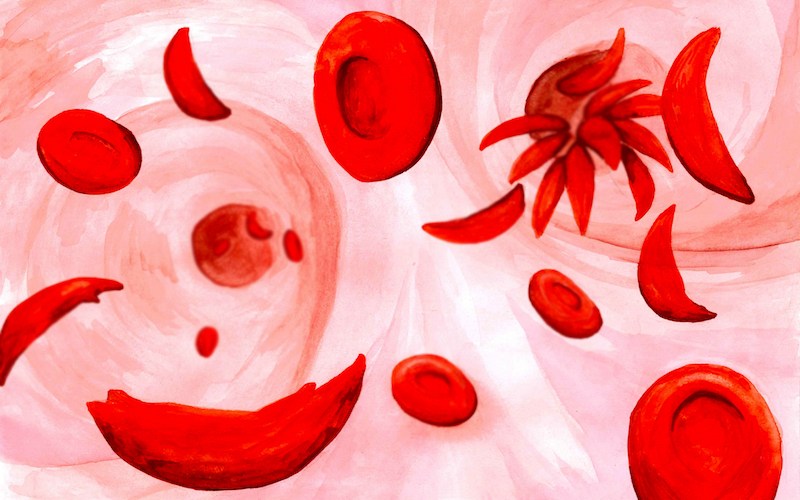Sickle cell gene therapy to boost fetal hemoglobin: A 70-year timeline of discovery

Boston Children’s Hospital is now enrolling patients age 3 to 35 in a clinical trial of gene therapy for sickle cell disease. Based on technology developed in its own labs, it differs from other gene therapy approaches by having a two-pronged action. It represses production of the mutated beta hemoglobin that causes red blood cells to form the stiff “sickle” shapes that block up blood vessels. It also increases production of the fetal form of hemoglobin, which people normally stop making after birth.
Fetal hemoglobin doesn’t sickle and works fine for oxygen transport. The gene therapy being tested now restores fetal hemoglobin production by turning “off” a silencing gene called BCL11A.
“BCL11A represses fetal hemoglobin and also activates beta hemoglobin, which is affected by the sickle-cell mutation,” David Williams, MD, the trial’s principal investigator, told Vector last year. Williams is also president of the Dana-Farber/Boston Children’s Cancer and Blood Disorders Center. “So when you knock BCL11A down, you simultaneously increase fetal hemoglobin and repress sickling hemoglobin, which is why we think this is the best approach to gene therapy in this disease.”
The therapy is the product of multiple discoveries, the first dating back 70 years. Click selected images below to enlarge.
1948: Fetal hemoglobin doesn’t sickle
Brooklyn pediatrician Janet Watson notes that children who later develop sickle cell disease have few sickled red blood cells as newborns. She ties this to their greater concentration of fetal hemoglobin, which does not cause cells to sickle, as compared with adult hemoglobin.
1949: Discovery of the sickle cell mutation
Sickle cell anemia becomes the first human disease to be understood on a molecular level. Famed chemist Linus Pauling and associates show that in patients with sickle cell disease, hemoglobin has an altered chemical structure.
1972-1990s: Fetal hemoglobin makes sickle cell milder
Starting with studies in Saudi Arabian populations, research shows that people with sickle cell disease who continue making fetal hemoglobin after infancy have a milder illness.
1980s: The development of modern gene delivery vectors
The modern era of virus “vectors” that deliver genes into cells begins when researchers at Boston Children’s Hospital and the Hospital for Sick Children in Toronto use retroviruses to “infect” cells and thereby transfer genes into them.
1994: Fetal hemoglobin boosts life expectancy
A 23-center U.S. study led by Orah Platt, MD, at Boston Children’s Hospital finds that people with sickle cell disease live longer if they have higher levels of fetal hemoglobin (HbF).
1995: Hydroxyurea emerges as sickle cell drug
A New England Journal of Medicine study finds that hydroxyurea, which reactivates fetal hemoglobin production, reduces the number and severity of sickle-cell attacks in adults. (Some of the early work was done by Platt and David Nathan, MD, at Boston Children’s.) Approved in 1998, hydroxyurea remains the only FDA-approved drug for sickle cell disease. But it can cause toxicity and helps only about half of all patients.
2008: A fetal hemoglobin silencer: BCL11A
Genome-wide association studies suggest that variants of the gene BCL11A (on chromosome 2 above) affect fetal hemoglobin production. Stuart Orkin and Vijay Sankaran at the Dana-Farber/Boston Children’s Cancer and Blood Disorders Center show that suppressing BCL11A restarts fetal hemoglobin production.
2011: Curing sickle cell in mice
Orkin and colleagues correct sickle-cell disease in mice by inactivating BCL11A, allowing fetal hemoglobin to be made.
2013-2015: A safer way to enhance fetal hemoglobin
Scientists at Dana-Farber/Boston Children’s and the Broad Institute find a DNA “enhancer” region that controls BCL11A only in red blood cells, making it a safer target. They later show that editing the enhancer with CRISPR-Cas9 technology boosts fetal hemoglobin production in mice and in human cells.
2016: A sickle cell gene therapy vector
Clearing a final preclinical hurdle, Dana-Farber/Boston Children’s researchers create a precision-engineered gene therapy vector that silences BCL11A only in precursors of red blood cells. It contains several levels of engineering: Its core is a short hairpin RNA (shRNA) that inactivates the BCL11A gene. The shRNA is then embedded in a microRNA (miR) to get it into the cell. Finally, this shRNA–miR assembly is hooked to a promoter of beta hemoglobin expression, together with an enhancer that is active only in red blood cell precursors.
When this vector was introduced into red blood cells from mice and from four patients with sickle cell disease, fetal hemoglobin crowded out the sickling “adult” beta hemoglobin, achieving fetal hemoglobin levels of at least 80 percent.
2017: Gene therapy trial opens
Visit Dana-Farber/Boston Children’s for details and eligibility criteria for the sickle cell gene therapy trial. For information on enrolling, email gene.therapy@childrens.harvard.edu.
Related Posts :
-

The dopamine reset: Restoring what’s missing in AADC deficiency
In March 2023, a young girl came to Boston Children’s Hospital unable to hold up her head — one striking symptom ...
-

“A setback for a comeback”: Brody perseveres with Paget-Schroetter Syndrome
Baseball has been part of Brody Walsh’s story from the very start. Now 19 and a college sophomore, Brody pitches ...
-

Tough cookie: Steroid therapy helps Alessandra thrive with Diamond-Blackfan anemia
Two-year-old Alessandra is many things. She’s sweet, happy, curious, and, according to her parents, Ralph and Irma, a budding ...
-

Unique data revealed just when Mickey’s heart doctors could operate
When Mikolaj “Mickey” Karski’s family traveled from Poland to Boston to get him heart care, they weren’t thinking ...





